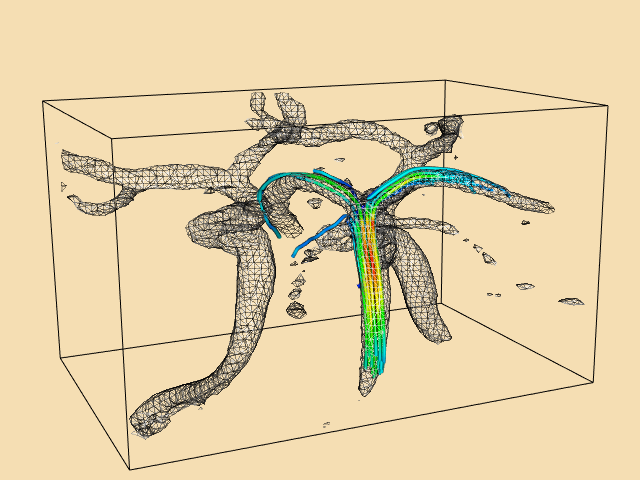CarotidFlow
Repository source: CarotidFlow
Description¶
This example generates streamtubes of blood velocity. an isosurface of speed provides context. The starting positions for the streamtubes were determined by experimenting with the data. Because of the way the data was measured and the resolution of the velocity field, many streamers travel outside the artery. This is because the boundary layer of the blood flow is not captured due to limitations in data resolution. Consequently, as the blood flows around curves, there is a component of the velocity field that directs the streamtube outside the artery. As a result it is hard to find starting positions for the streamtubes that yield interesting results. The examples uses the source object vtkPointSource in combination with vtkThresholdPoints to work around this problem. vtkPointSource generates random points centered around a sphere of a specified radius. We need only find an approximate position for the starting points of the streamtubes and then generate a cloud of random seed points. vtkThresholdPoints is used to cull points that may be generated outside the regions of high flow velocity.
Cite
See 3D Phase Contrast MRI of Cerebral Blood Flow and Surface Anatomy for background.
Info
See Figure 6-44 in Chapter 6 the VTK Textbook.
Other languages
See (Cxx)
Question
If you have a question about this example, please use the VTK Discourse Forum
Code¶
CarotidFlow.py
#!/usr/bin/env python
# noinspection PyUnresolvedReferences
import vtkmodules.vtkInteractionStyle
# noinspection PyUnresolvedReferences
import vtkmodules.vtkRenderingOpenGL2
from vtkmodules.vtkCommonColor import vtkNamedColors
from vtkmodules.vtkCommonCore import vtkLookupTable
from vtkmodules.vtkFiltersCore import (
vtkContourFilter,
vtkThresholdPoints,
vtkTubeFilter
)
from vtkmodules.vtkFiltersFlowPaths import vtkStreamTracer
from vtkmodules.vtkFiltersModeling import vtkOutlineFilter
from vtkmodules.vtkFiltersSources import vtkPointSource
from vtkmodules.vtkIOLegacy import vtkStructuredPointsReader
from vtkmodules.vtkRenderingCore import (
vtkActor,
vtkCamera,
vtkPolyDataMapper,
vtkRenderWindow,
vtkRenderWindowInteractor,
vtkRenderer
)
def main():
fileName = get_program_parameters()
colors = vtkNamedColors()
ren1 = vtkRenderer()
renWin = vtkRenderWindow()
renWin.AddRenderer(ren1)
iren = vtkRenderWindowInteractor()
iren.SetRenderWindow(renWin)
# Create the pipeline.
#
reader = vtkStructuredPointsReader()
reader.SetFileName(fileName)
psource = vtkPointSource()
psource.SetNumberOfPoints(25)
psource.SetCenter(133.1, 116.3, 5.0)
psource.SetRadius(2.0)
threshold = vtkThresholdPoints()
threshold.SetInputConnection(reader.GetOutputPort())
threshold.ThresholdByUpper(275)
streamers = vtkStreamTracer()
streamers.SetInputConnection(reader.GetOutputPort())
streamers.SetSourceConnection(psource.GetOutputPort())
# streamers.SetMaximumPropagationUnitToTimeUnit()
streamers.SetMaximumPropagation(100.0)
# streamers.SetInitialIntegrationStepUnitToCellLengthUnit()
streamers.SetInitialIntegrationStep(0.2)
streamers.SetTerminalSpeed(.01)
streamers.Update()
scalarRange = [0] * 2
scalarRange[0] = streamers.GetOutput().GetPointData().GetScalars().GetRange()[0]
scalarRange[1] = streamers.GetOutput().GetPointData().GetScalars().GetRange()[1]
print("range: ", scalarRange[0], ", ", scalarRange[1])
tubes = vtkTubeFilter()
tubes.SetInputConnection(streamers.GetOutputPort())
tubes.SetRadius(0.3)
tubes.SetNumberOfSides(6)
tubes.SetVaryRadius(0)
lut = vtkLookupTable()
lut.SetHueRange(.667, 0.0)
lut.Build()
streamerMapper = vtkPolyDataMapper()
streamerMapper.SetInputConnection(tubes.GetOutputPort())
streamerMapper.SetScalarRange(scalarRange[0], scalarRange[1])
streamerMapper.SetLookupTable(lut)
streamerActor = vtkActor()
streamerActor.SetMapper(streamerMapper)
# Speed contours.
iso = vtkContourFilter()
iso.SetInputConnection(reader.GetOutputPort())
iso.SetValue(0, 175)
isoMapper = vtkPolyDataMapper()
isoMapper.SetInputConnection(iso.GetOutputPort())
isoMapper.ScalarVisibilityOff()
isoActor = vtkActor()
isoActor.SetMapper(isoMapper)
isoActor.GetProperty().SetRepresentationToWireframe()
isoActor.GetProperty().SetOpacity(0.25)
# Outline
outline = vtkOutlineFilter()
outline.SetInputConnection(reader.GetOutputPort())
outlineMapper = vtkPolyDataMapper()
outlineMapper.SetInputConnection(outline.GetOutputPort())
outlineActor = vtkActor()
outlineActor.SetMapper(outlineMapper)
outlineActor.GetProperty().SetColor(colors.GetColor3d("Black"))
# Add the actors to the renderer, set the background and size.
#
ren1.AddActor(outlineActor)
ren1.AddActor(streamerActor)
ren1.AddActor(isoActor)
ren1.SetBackground(colors.GetColor3d("Wheat"))
renWin.SetSize(640, 480)
renWin.SetWindowName('CarotidFlow')
cam1 = vtkCamera()
cam1.SetClippingRange(17.4043, 870.216)
cam1.SetFocalPoint(136.71, 104.025, 23)
cam1.SetPosition(204.747, 258.939, 63.7925)
cam1.SetViewUp(-0.102647, -0.210897, 0.972104)
cam1.Zoom(1.2)
ren1.SetActiveCamera(cam1)
# Render the image.
#
renWin.Render()
iren.Start()
def get_program_parameters():
import argparse
description = 'Visualizing blood flow in human carotid arteries.'
epilogue = '''
Streamtubes of blood velocity are generated.
'''
parser = argparse.ArgumentParser(description=description, epilog=epilogue,
formatter_class=argparse.RawDescriptionHelpFormatter)
parser.add_argument('filename', help='carotid.vtk')
args = parser.parse_args()
return args.filename
if __name__ == '__main__':
main()
